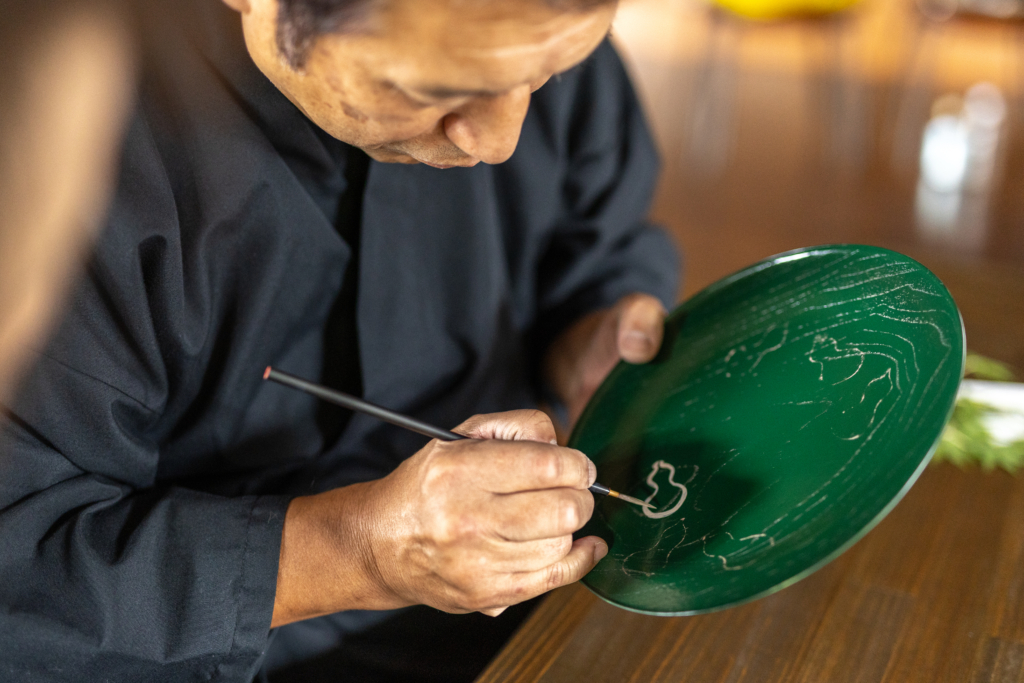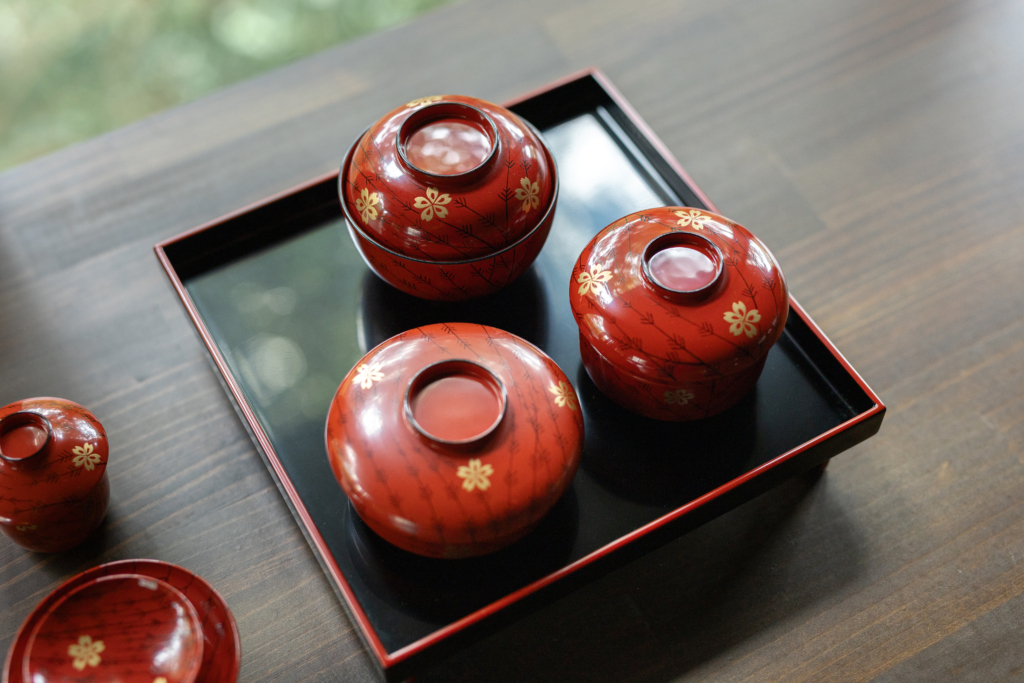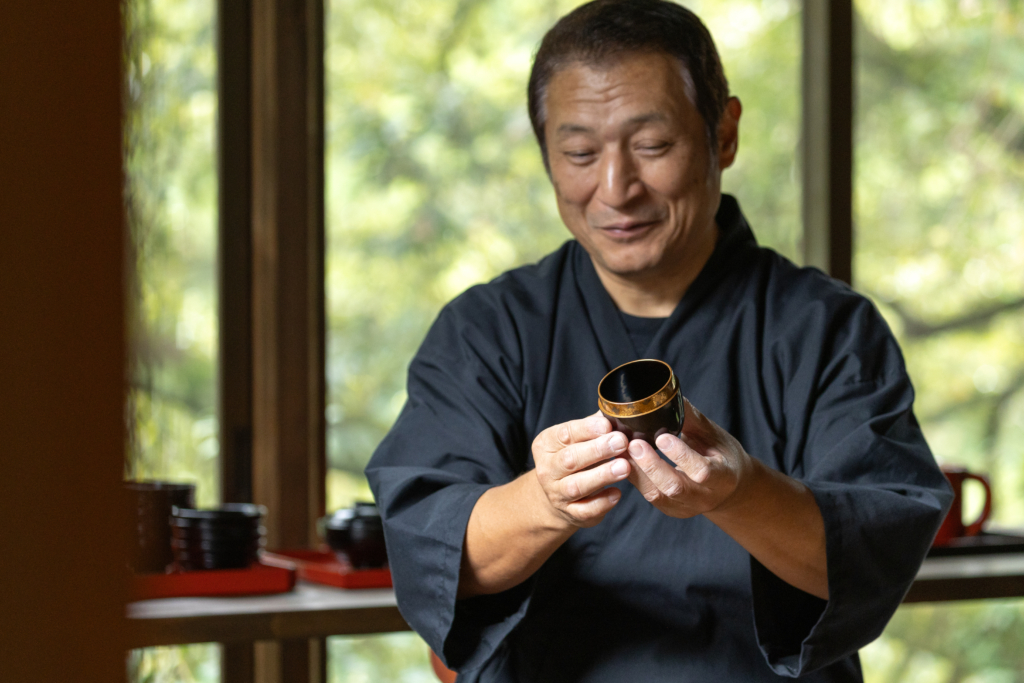
More than 400 years of history and culture in a hot spring resort area The World of the Maehata Family, Craftsmen and Tea Masters
Yamanaka Onsen in Kaga City, Ishikawa Prefecture. Yamanaka lacquerware, with a history spanning over 400 years, is a symbol of Japan’s representative traditional crafts. The lacquerware culture, passed down through generations in the unique climate of Yamanaka Onsen, continues to thrive today through the hands of local artisans. We spoke with Shunsai Maehata, a lacquerware artist, about his passion for lacquerware, his new challenges, and his thoughts on the local community.
A History and Family Legacy that Dates Back to the Shogunate Period
Yamanaka Onsen, located in Kaga City, Ishikawa Prefecture, is known as one of the leading hot spring resorts in the Hokuriku region. Its history dates back to the Nara period, making it a renowned hot spring with over 1,300 years of tradition. The natural beauty of the four seasons and the charming atmosphere of the hot spring town captivates visitors. It is also a region rich in traditional crafts, where representative Japanese art forms such as Yamanaka lacquerware and Kutani porcelain have been born and nurtured.
“The formalization of our workshop into a corporation happened in my father’s generation, but the history of our family business goes back to the time of the Daishoji Domain. Our ancestors supported the region as samurai, and in my great-grandfather’s time, the family was involved in a variety of industries such as mining, forestry, and agriculture. My great-grandfather was active in the area where Kutani ware originated, and there is even a memorial to the potter Goto Saijiro.
However, the impact of the Great Depression led to the decline of the mining business, and the family business entered a period of transformation. Afterward, my grandfather dedicated himself to wood processing and lacquerware production in Yamanaka Onsen, and my father expanded business dealings with Kyoto and Tokyo. The workshop grew into a large operation, employing many apprentices. I am gradually continuing this legacy,”
In his words, one can feel the deep connection between family and the local community. Not only has the tradition been passed down, but the resilience to overcome the challenges of each era while preserving both technology and culture reflects a long history of trial, error, and perseverance.

Lacquerware Production Evolving with the Times
“During the post-war period of rapid economic growth, the demand for lacquerware increased dramatically. In particular, the demand for tea ceremony utensils was high, and my father worked on many pieces. The workshop was always bustling with craftsmen and apprentices coming and going,” Mr. Maehata recalls of that time.
At the same time, the changing times steadily impacted on the lacquerware industry. “With the collapse of the bubble economy and the stagnation of the economy, alongside the progression of an aging and declining population, the market size began to shrink. Despite managing to continue, the recent COVID-19 pandemic has brought about even more challenging circumstances. The amount of work has drastically decreased, and the number of apprentices and craftsmen visiting the workshop has also declined,” he shares about the difficult situation.
However, Mr. Maehata is not one to merely succumb to pessimism. “Our work isn’t just about creating products. It’s about how we pass on traditional techniques and culture to the next generation. That’s our greatest challenge now,” he emphasizes.
From the post-war period of prosperity to the challenges of the modern era, the history of lacquerware production has experienced significant waves. Nevertheless, through Mr. Maehata’s words, one can sense a forward-looking attitude as he strives to carry on his father’s legacy while exploring new designs for the future.
The Spirit of Lacquer Art Conveyed Through Tribute Pieces
Mr. Maehata’s lacquer art pieces, known for their high craftsmanship and artistic value, have been presented as tribute gifts to the Pope and the Emperor of Japan. These works not only symbolize Japan’s traditional crafts but also play an important role in cultural exchange and the utilization of local resources.
The tribute piece for the Pope was commissioned through the Musashikoji Senke and was based on an old craft piece, a tea utensil. “I used white lacquer to create a tea utensil resembling ivory, with Christian symbols such as grapes and the ‘IHS’ design, which I applied in gold and silver maki-e,” Mr. Maehata recalls. That tea utensil is still carefully preserved in the Vatican, demonstrating the cultural value of lacquer art to the world.
On the other hand, the tribute piece for the Emperor was made from a dead pine tree from the Numazu Imperial Villa. “The intent was to make use of the local nature. I dried the pine wood, highlighted the grain with lacquer, and then painted pine waves and a red Mount Fuji using maki-e. Red Mount Fuji has long been a symbol of celebration, and this piece embodies the region’s nature and culture,” Mr. Maehata explains. The tribute piece was personally accepted by the Emperor and was later displayed in the Numazu Imperial Villa Memorial Museum.
“Being entrusted with such important work alongside my father is a great source of pride as a lacquer artist. Lacquerware is not just a craft; it connects culture, history, and people’s thoughts,” Mr. Maehata shares. These experiences of creating tribute pieces made him realize anew the potential of lacquer art. The skills and intentions embedded in these tribute works have become a symbolic representation of connecting Japan’s traditional culture to the future.

Childhood Memories and the Root of His Craftsmanship
“Our workshop was part of our home, so my father’s workspace was a natural part of everyday life. The distinctive smell of lacquer, the sound of wood being carved, and the sight of craftsmen at work were all around me. Even as a child, I would mimic their movements and play by handling the tools.” recalls Mr. Maehata as he reflects on his childhood.
One particularly memorable moment occurred when he was about three years old. “I accidentally stuck one foot into a lacquer bucket, and my father quickly used oil to remove the lacquer. Lacquer can cause skin irritation, so my father was worried, but fortunately, I was unharmed. Perhaps that made me feel like I had a connection to lacquer in some way,” he smiles.
As he grew older, his involvement in lacquerware production became more serious during his high school years. “In high school, I learned the basics from my father and the craftsmen at the workshop, and also studied under a teacher in Kanazawa. The teacher was strict and kept repeating, ‘Maki-e is not just painting. You must observe real nature carefully and capture its structure accurately,'” Mr. Maehata recalls.
This teaching instilled in him not just the ability to replicate natural forms, but also the mindset of an artisan who imbues his work with soul by truly understanding the real thing. “For example, you must thoroughly understand how a leaf’s stem emerges and how veins run before you can accurately draw it. If you don’t, it’s just imitation. I was rigorously trained in these aspects by my teacher,” Mr. Maehata continues.
By observing nature, the reality and vitality embedded in maki-e are brought to life. The experience of being thoroughly trained in this fundamental principle continues to underpin his work today.
“Maki-e is not just decoration; it has a sense of capturing nature itself within it. What I learned from my teacher lives on in my current work,” Mr. Maehata explains.
The memories of playing in the workshop as a child and the rigorous training that emphasized the importance of observing nature are at the core of Mr. Maehata’s craftsmanship. Each of these memories serves as the foundation for the meticulous detail and rich expressiveness seen in his work.

Passing on the Lacquerware Culture to the Next Generation through Experience
“Mugen-an was established in the relocated residence of the Yokoyama family, a branch of the Maeda clan’s prominent officials, built in the first year of the Taisho era,” explains Mr. Maehata. Originally located in Kanazawa city, the building was moved to the Yamanaka Onsen area, where it now serves as a hub for regional culture and is preserved for use.
“My father founded Mugetsu-an as a public foundation about 40 years ago. He strongly felt the need to preserve and pass down traditional crafts, and opened it as a facility to promote local culture,” he continues. The house, built in the samurai study style, has been restored to maintain its historical value while serving as a platform to promote Yamanaka Onsen’s culture and traditional crafts.
Mugen-an consists mainly of three facilities. The new building, “Uruhashi-kan,” was renovated by Maehata’s father during the Heisei era. “The name comes from the word ‘uruwashii,’ which means ‘beautiful,’ as it is the origin of the word for lacquer. The first floor is open as a café where visitors can enjoy coffee or matcha served in Yamanaka lacquerware. The second floor is used as an exhibition space and private dining area, and is also available for meetings and special exhibitions,” Mr. Maehata explains.
Mugen-an allows visitors to directly engage with lacquerware culture and deepen their understanding of it. “Many visitors, especially those from overseas, are experiencing lacquerware for the first time. We try to make sure they can appreciate its beauty and value through hands-on experiences. I’d be happy if they come to realize that lacquerware is an important part of Japanese culture,” he shares.
Additionally, Mr. Maehata emphasizes the importance of linking local resources. “By combining onsen culture and local food with lacquerware, we promote the overall charm of Yamanaka Onsen. For example, the kaiseki meals served at Mugen-an use lacquerware made by us. The seasonal presentation on the lacquerware makes a beautiful visual experience. It’s an opportunity for visitors to appreciate the charm of lacquerware as dinnerware, enjoying the harmony between the food and the dishes, which is one of the unique aspects of lacquerware.”
Reflecting on the challenges posed by the COVID-19 pandemic, Mr. Maehata expresses the renewed importance of preserving regional culture. “Tourism dropped, and the entire region was greatly affected. During this time, I realized how important it is to continue promoting the local attractions. By connecting the onsen culture, nature, food, and lacquerware of Yamanaka Onsen, I hope to help people rediscover the value of this area.”
Mr. Maehata’s efforts, centered on lacquerware culture, are expanding beyond traditional crafts to highlight the entire region’s appeal and connect it to the future.

Yamanaka Lacquerware: A Symbol of Kaga’s Rich Culture
“Ishikawa Prefecture is home to traditional crafts such as Yamanaka lacquerware, along with onsen culture and abundant natural beauty. With the opening of the new Shinkansen line, access has improved, and I hope many people will visit. It would be wonderful if they could experience the depth of Japan’s traditional culture in this area,” says Mr. Maehata.
His words convey not just the allure of the region as a tourist destination, but also a deep affection for its history and culture. Yamanaka lacquerware, as the representative traditional craft of Yamanaka Onsen, symbolizes the very spirit and culture of the region. Mr. Maehata’s strong desire for visitors to experience its charm is evident in his words.
The beauty of Ishikawa, where traditional crafts, nature, and onsen culture come together harmoniously, is encapsulated in Yamanaka lacquerware. Through Mr. Maehata’s words, one can sense his profound pride in the region and his sincere wish for visitors to enjoy their time there. A visit to Yamanaka Onsen promises a special opportunity to immerse oneself in the richness of Japanese culture.
Shunsai Maehata
Born in 1964. Prominent figure from Yamanaka Onsen in Kaga City, Ishikawa Prefecture, and the eighth-generation head of the Maehata family, a renowned lineage in traditional lacquerware. In 1985, he inherited the title of the third-generation Shunsai Maehata and studied lacquerware and Kaga Maki-e (gold lacquer) under the guidance of his father and artist Minoru Hoya. His works are characterized by their luxurious designs and freshness, and he developed a new technique called “To-shitsu,” which combines ceramics and lacquer. Focusing on the creation of tea utensils, he has gained high recognition as a contemporary tea utensil maker while also teaching the techniques of Maki-e.

If you would like to visit MUGEN-AN and get further into the world of Yamanaka lacquerware, please see the following information
Enjoy the charm of Yamanaka lacquerware, one of Japan’s three major types of lacquerware, and tea ceremony
Highlights
・Guided tour of Yamanaka Lacquerware, one of the three major lacquerware in Japan.
・Guided tour of the MUGEN-AN museum where you can feel the culture of craftsmanship.
・Enjoy matcha green tea while appreciating Yamanaka lacquerware.
Information
Fee: 5,000 yen per person
Participants: 1 to 6 persons
Duration: Approximately 1.5 hours
Included: MUGEN-AN tour fee, Matcha tea fee
Meeting place: MUGEN-AN parking lot
Language: Japanese (English interpreter can be arranged upon request)
For reservation inquiries, please click here.